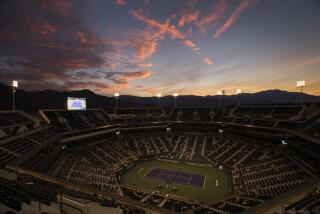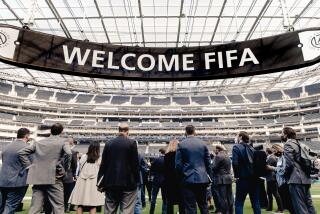COMMENTARY : Keep Nation’s Biggest Tennis Event in Big Apple
- Share via
NEW YORK — The U.S. Open Tennis Championships begin Monday with a nagging but immensely important off-court decision to be made: On which surface and where will the U.S. Tennis Association stage future Opens? There is a consensus of sorts among officials--and certainly among the players--that the present site at Flushing Meadow Park in Queens is neither adequate nor aesthetically pleasing. The lease there ends in 1994.
When former USTA president “Slew” Hester, who conceived and oversaw the construction of the National Tennis Center at Flushing Meadow in the late 1970s, was asked some years ago about the lack of tradition there, he said, “You want tradition, we’ll plant some ivy.” His response may have been interpreted as flip, but he was really saying that the USTA had no choice but to move the Open from the West Side Tennis Club in Forest Hills. Ivy or no ivy, West Side was simply too small.
The move in 1978 to the 16-acre plot just a quarter-mile south of Shea Stadium was the fourth since the USTA Nationals--as the championship tournament was originally known--began back in 1881. All the moves were for the same reason: The old accommodations were insufficient.
Among players, the U.S. Open is the least favorite of the four major international championships. It has incurred indefensibly high maintenance costs because the entire 1,346 acres of Flushing Meadow Park are built on reclaimed marsh. We’re talking swamp, so the 26 DecoTurf II cement courts sink a little at times, a process that leaves them uneven, if not cracked. The Open, with its noise, traffic, crowds and raucous ambience, is also an embarrassment to America’s tennis establishment when compared to the gentility of the All-England Club at Wimbledon, the savoir-faire of Roland Garros Stadium in Paris and state-of-the-art Flinders Park in Melbourne, Australia.
Even if there is a move, the consensus is that the Open will almost certainly stay in New York City. “London, Paris, Melbourne . . . Cleveland” doesn’t sound right, though I have nothing personal against Cleveland. And any city south of St. Louis is probably too hot in late August.
New York City Mayor David Dinkins should lobby long and laboriously to keep the Open--in fact, he’s already persuaded the Federal Aviation Administration to try to keep jets leaving LaGuardia Aiport from flying over the tennis center during tournament hours this year. The Open brings $100 million to the city every year. The gross to the city from the Open is greater than the gross from a seven-game World Series, even if it were the New York Yankees against the New York Mets. Put another way, the Open is the biggest sports event in the biggest city in America. Though USTA president David Markin may not want to shut the door publicly to plausible bids from other cities, I strongly believe the USTA wants to keep it in the Big Apple. As a proud New Yorker, so do I.
The choice of surface is a separate but vital issue. The Open was first a captive of tradition and now of expediency. Wimbledon, Melbourne and Forest Hills were all grass until 1975, when the West Side courts were changed to clay. The Open went to cement at Flushing Meadow in 1978. Melbourne changed to Rebound Ace (a user-friendly cement) two years ago.
My guess is that the new surface will be the same as now, or something similar to Rebound Ace with a Made-in-the-USA label. Why? Maintenance costs for the Open, and for the 49 weeks the tennis courts are open to the public, would be kept to manageable levels. Then there is the overwhelming conversion to hard courts over the last 20 years at colleges, public parks and indoor private clubs. Most of the USTA’s elite junior events are on cement, and our elite junior players know little else.
The U.S. summer circuit of tournaments leading up to the Open finale would have to adopt any surface change, and few top players want to play on slow clay courts in July and August. They would have to work too hard: Games on clay are longer and more arduous than on faster surfaces.
On the other hand, USTA research shows that the constant jarring and pounding to which hard courts subject the joints pose serious problems to developing adolescent bodies. In fact, a prime concern of those compiling this data is just where that theoretical line lies that divides optimum player preparation from unnecessary stress and injury. Too many of America’s young hotshots, girls in particular, have had to push the pause button within 18 months of the start of their professional careers.
Wherever in Queens the new facility winds up (the other four boroughs are long shots), it will also reflect the fiscal realities of the next television contract.
More to Read
Go beyond the scoreboard
Get the latest on L.A.'s teams in the daily Sports Report newsletter.
You may occasionally receive promotional content from the Los Angeles Times.










